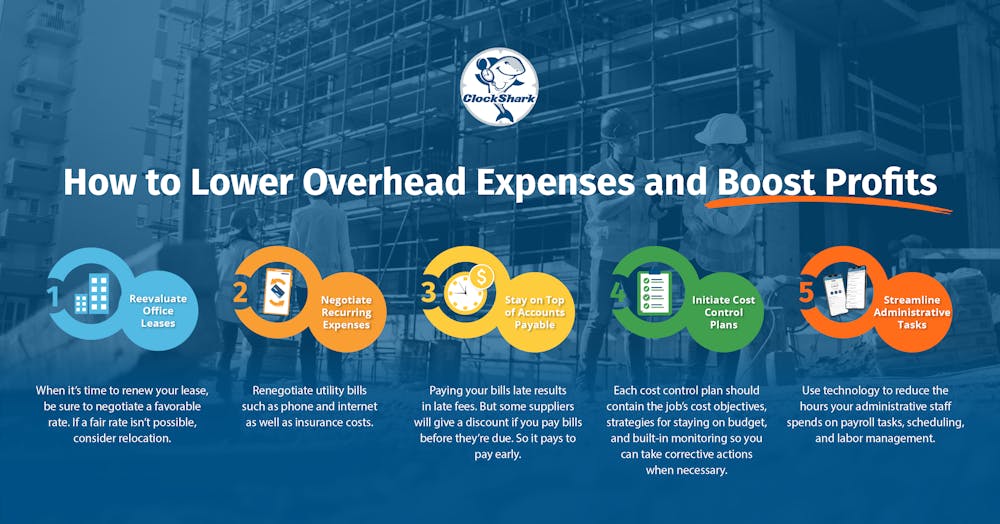If you aren’t paying close attention to your overhead, then the cost of doing business could be running your business into the ground. Miscalculating overhead skews financials and results in improperly bid jobs, too-low profit margins, and restricted cash flow – all detriments to any construction company.
Here’s what you need to know to estimate these sneaky costs better, starting with which expenses count as overhead.
What Is Overhead vs. Direct Cost?
Overhead costs are the indirect, or “hidden,” expenses it takes to run your business – the ones necessary to keep your business afloat and manage your projects.
Direct costs are the expenses it takes to complete a specific project. The number of 2x4s you need to frame your latest design-build or the amount of concrete you need to complete your latest multifamily project count as direct costs.
That seems straightforward. But the overlap between overhead and direct costs can make overhead allocation a bit murky.
Here’s an example of how overhead and direct costs are related but aren’t the same thing:
If you pay an employee to pour concrete footers for a hotel build, those work hours are a direct job cost. If the hotel project didn’t exist, that labor would not be needed. But the costs associated with that labor – like payroll taxes, workers comp, and other indirect expenses related to the employee’s labor burden – count as overhead. Those costs would be necessary to keep the employee whether the hotel was built or not.
Construction overhead costs fall into two categories: project overhead and company overhead.
Project Overhead
Project overhead is sometimes called direct overhead because it’s directly related to the construction process. But be careful not to confuse direct overhead with direct costs. Direct costs belong to a single project. Direct overhead is shared across multiple projects.
Here are a few examples of direct overhead costs:
- Brads, nails, screws, and other small fasteners that are impractical to count per job
- The price paid for owned construction equipment
- The depreciation, repairs, and maintenance of owned construction equipment
- The lease price for rented equipment used across multiple jobs
- The cost of fuel to operate vehicles and machinery
All these expenses are directly related to the construction process, but they can’t be attributed to a single build.
Company Overhead
Rather than supporting the construction process, company overhead supports your organization as a whole. These costs exist whether you have billable work or not.
Here are some examples of company overhead expenses:
- Office rent and utilities
- Administrative salaries
- Advertising expenses
- Legal fees
- Bonding and insurance costs
- The cost of hiring employees
Each of these categories should be closely tracked and included in your markup.

Why Is Tracking Overhead So Important?
Tracking overhead expenses is more nuanced in construction than in most other industries. It can be confusing – frustrating even – but there’s no other way to get a true picture of your profit margins or an accurate representation of job performance.
If you’re having difficulty making a profit on your projects – even though your estimated direct costs closely match your actual costs – then your overhead expenses are likely to blame.
You can’t fully understand how much overhead costs your business unless you track all your indirect expenses and allocate them to the right cost pools. Each company’s needs are individualized, so check with your accountant to decide the best allocation method for you. But as a rule, using a granular approach for calculating overhead works better for large construction companies than using broad estimations.
For example, using the 10 X 10 method, which assumes 10 percent overhead and 10 percent profit, is acceptable for smaller companies. But it isn’t granular enough for large construction firms to get an accurate picture of overhead costs.
It’s much more profitable for enterprise companies to use specific cost pools that account for administrative overhead, advertising overhead, labor burden, etc., on a per-project basis.
Taking a granular approach ensures that you don’t under-calculate your overhead and underbid jobs. Plus, it gives transparency into whether or not you’re spending too much on overhead.
If your overhead expenses are too high, you won’t be able to price competitively and win projects. Or even if you do win bids, your overhead costs will eat into any profits you make from them.
How Can You Lower Overhead Expenses and Boost Profits?
Not every overhead expense is necessary. Even the ones that are necessary can often be negotiated down. Use these tips to lower construction overhead and boost profit margins.
1. Reevaluate Office Leases
After materials and labor, office leases are the largest expense for construction firms. When it’s time to renew your lease, be sure to negotiate a favorable rate. If a fair rate isn’t possible, consider relocation. Sometimes relocating is more cost-effective than staying put. You might also consider changing your infrastructure to allow administrators to work from home. This lessens the need for large office spaces.
2. Negotiate Recurring Expenses
Rather than letting recurring costs auto-renew, check for price increases and negotiate them down. Or find more competitive rates elsewhere. You can renegotiate utility bills such as phone and internet as well as insurance costs. While most recurring expenses will increase over time, there’s no need to leave them unchecked.
3. Stay on Top of Accounts Payable
Paying your bills late results in late fees. But some suppliers will give a discount if you pay bills before they’re due. So it pays to pay early.
4. Initiate Cost Control Plans
Every project should include a cost control plan. Each plan should contain the job’s cost objectives, strategies for staying on budget, and built-in monitoring so you can take corrective actions when necessary.
5. Streamline Administrative Tasks
Use technology like Clockshark to reduce the hours your administrative staff spends on payroll tasks, scheduling, and labor management.
Knowing Keeps You Growing
If you stay on top of your job costs and track your overhead expenses, you will have the information you need to bid well, keep overhead low, and improve your project margins. The more insight you have into your financials, the more you can grow your business.If you’d like to find out your employees’ true labor costs, use Clockshark’s free Labor Burden Calculator.








